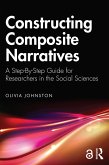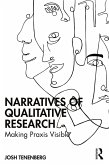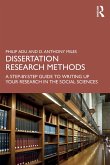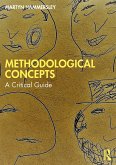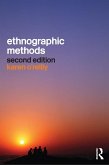Constructing Composite Narratives (eBook, ePUB)
A Step-By-Step Guide for Researchers in the Social Sciences


Alle Infos zum eBook verschenken

Constructing Composite Narratives (eBook, ePUB)
A Step-By-Step Guide for Researchers in the Social Sciences
- Format: ePub
- Merkliste
- Auf die Merkliste
- Bewerten Bewerten
- Teilen
- Produkt teilen
- Produkterinnerung
- Produkterinnerung

Hier können Sie sich einloggen

Bitte loggen Sie sich zunächst in Ihr Kundenkonto ein oder registrieren Sie sich bei bücher.de, um das eBook-Abo tolino select nutzen zu können.
This book provides the first instructional guide to composite narrative research methods. Composite narratives are short vignettes that weave together quotes from multiple participants. The effect is to convey meaning to both academics and end-users, disseminating research findings succinctly and effectively. Readers interested in writing composite narratives will find a complete guide in this book.
More and more researchers are using composite narratives to present their research findings, with support for the effectiveness of composite narratives as a research method growing. Inside this…mehr
- Geräte: eReader
- mit Kopierschutz
- eBook Hilfe
![Constructing Composite Narratives (eBook, PDF) Constructing Composite Narratives (eBook, PDF)]() Olivia JohnstonConstructing Composite Narratives (eBook, PDF)39,95 €
Olivia JohnstonConstructing Composite Narratives (eBook, PDF)39,95 €![Narratives of Qualitative Research (eBook, ePUB) Narratives of Qualitative Research (eBook, ePUB)]() Josh TenenbergNarratives of Qualitative Research (eBook, ePUB)52,95 €
Josh TenenbergNarratives of Qualitative Research (eBook, ePUB)52,95 €![Dissertation Research Methods (eBook, ePUB) Dissertation Research Methods (eBook, ePUB)]() Philip AduDissertation Research Methods (eBook, ePUB)42,95 €
Philip AduDissertation Research Methods (eBook, ePUB)42,95 €![Methodological Concepts (eBook, ePUB) Methodological Concepts (eBook, ePUB)]() Martyn HammersleyMethodological Concepts (eBook, ePUB)34,95 €
Martyn HammersleyMethodological Concepts (eBook, ePUB)34,95 €![Research Methods for African Scholarship (eBook, ePUB) Research Methods for African Scholarship (eBook, ePUB)]() Kehbuma LangmiaResearch Methods for African Scholarship (eBook, ePUB)42,95 €
Kehbuma LangmiaResearch Methods for African Scholarship (eBook, ePUB)42,95 €![How to Write Conceptual Papers in the Social Sciences (eBook, ePUB) How to Write Conceptual Papers in the Social Sciences (eBook, ePUB)]() Jon-Arild JohannessenHow to Write Conceptual Papers in the Social Sciences (eBook, ePUB)42,95 €
Jon-Arild JohannessenHow to Write Conceptual Papers in the Social Sciences (eBook, ePUB)42,95 €![Ethnographic Methods (eBook, ePUB) Ethnographic Methods (eBook, ePUB)]() Karen O'ReillyEthnographic Methods (eBook, ePUB)45,95 €
Karen O'ReillyEthnographic Methods (eBook, ePUB)45,95 €-
-
-
More and more researchers are using composite narratives to present their research findings, with support for the effectiveness of composite narratives as a research method growing. Inside this book, there is a rationale for why to use composite narratives and a complete guide for how to write them. Many examples from the author are provided, complete with audit trails that evidence how the composite narratives were written from the raw qualitative research data.
Social science researchers at all career stages will be able to use this book to justify and construct composite narratives. Beginning with a discussion of this background, the proposed book will offer research students, supervisors, and experienced academics a manual for how and why to use composite narratives in social sciences research. The intended audience includes qualitative researchers in the social sciences.
Chapter 4 of this book is freely available as a downloadable Open Access PDF at http://www.taylorfrancis.com under a Creative Commons Attribution (CC-BY) 4.0 license.
Dieser Download kann aus rechtlichen Gründen nur mit Rechnungsadresse in A, B, BG, CY, CZ, D, DK, EW, E, FIN, F, GR, HR, H, IRL, I, LT, L, LR, M, NL, PL, P, R, S, SLO, SK ausgeliefert werden.
- Produktdetails
- Verlag: Taylor & Francis eBooks
- Seitenzahl: 128
- Erscheinungstermin: 2. April 2024
- Englisch
- ISBN-13: 9781040010563
- Artikelnr.: 70096881
- Verlag: Taylor & Francis eBooks
- Seitenzahl: 128
- Erscheinungstermin: 2. April 2024
- Englisch
- ISBN-13: 9781040010563
- Artikelnr.: 70096881
- Herstellerkennzeichnung Die Herstellerinformationen sind derzeit nicht verfügbar.
background to composite narratives in the literature. Philosophical
foundations of composite narratives. Evoking the felt sense. Chapter 3: An
overview of methods for qualitative data collection and analysis.
Qualitative research. Grounded theory research methods. Phenomenological
research methods. Representing qualitative research findings. Chapter 4:
Six steps for constructing composite narratives. An example of how to
construct a composite narrative. STEP 1: Develop a narrative thread (a
storyline) for the first half of the narrative. STEP 2: Build the first
half of the narrative. STEP 3: Develop a narrative thread for the second
half of the narrative. STEP 4: Build the second half of the narrative. STEP
5: Edit and structure the narrative. STEP 6: Assign a meaningful title.
Summary of steps for constructing composite narratives. Chapter 5: Record
keeping: Audit trails for composite narrative constructions. Credibility of
composite narratives. Example of audit trail for step 1: Developing the
narrative thread. Example of audit trail for step 2: Build the narrative
thread. Dependability. Example of audit trail for step 3: Develop the
second narrative thread. Example of an audit trail for step 4: Building the
second half of the narrative. Confirmability. Transferability. Example of
an audit trail for step 5: Write a short introductory and concluding
paragraph. Example of audit trail for step 6: Choose a meaningful title.
Summary of rigor in composite narratives. Chapter 6: Other methods for
constructing composite narratives. Depth and structure. Voice in composite
narratives. Chapter 7: Context of the narratives: A study about students'
experiences of their teachers' expectations of them. Chapter 8: Eight
examples of composite narratives about students' experiences with audit
trails. Narrative 1: 'Expecting my best'. Narrative 2: 'A ping pong ball in
a balloon'. Narrative 3: 'More like a boss'. Narrative 4: 'A model city'.
Narrative 5: 'Seeming to smile'. Narrative 6: Designing my own future.
Narrative 7: 'Backbone'. Narrative 8: 'Right on the money'. Narrative 9:
'My socks don't matter today'. Narrative 10: 'What's in it for you?'. The
main research findings conveyed through Narratives 1-10. Chapter 9: 15
further narratives about students' experiences with a meta-narrative index.
The meta-narrative - An index for 24 composite narratives. Letter to
teacher: From your year 10 student. Narrative 11: 'Feeling smart'.
Narrative 12: 'A part of the class'. Narrative 13: 'Will I ever get it?'.
Narrative 14: 'The golden rule'. Narrative 15: 'Refreshing my mind'.
Narrative 16: 'I'd rather class be pretty chilled'. Narrative 17: 'Feeling
the heat'. Narrative 18: 'Anatomy of interest'. Narrative 19:
'Daydreaming'. Narrative 20: 'Facing inadequacy'. Narrative 21: 'Bothered'.
Narrative 22: 'On my own'. Narrative 23: 'Sooner or later'. Narrative 24:
'Derailing a dictator'. Summary of main research findings conveyed in
Narratives 9-24. Chapter 10: Evidence of composite narrative efficacy in
communicating findings to research end-users. The Teacher Expectation
Intervention. Using Composite Narratives for Research Impact. Findings
about the effectiveness of composite narratives. Discussion of composite
narratives for disseminating research findings. Chapter 11: Conclusion.
background to composite narratives in the literature. Philosophical
foundations of composite narratives. Evoking the felt sense. Chapter 3: An
overview of methods for qualitative data collection and analysis.
Qualitative research. Grounded theory research methods. Phenomenological
research methods. Representing qualitative research findings. Chapter 4:
Six steps for constructing composite narratives. An example of how to
construct a composite narrative. STEP 1: Develop a narrative thread (a
storyline) for the first half of the narrative. STEP 2: Build the first
half of the narrative. STEP 3: Develop a narrative thread for the second
half of the narrative. STEP 4: Build the second half of the narrative. STEP
5: Edit and structure the narrative. STEP 6: Assign a meaningful title.
Summary of steps for constructing composite narratives. Chapter 5: Record
keeping: Audit trails for composite narrative constructions. Credibility of
composite narratives. Example of audit trail for step 1: Developing the
narrative thread. Example of audit trail for step 2: Build the narrative
thread. Dependability. Example of audit trail for step 3: Develop the
second narrative thread. Example of an audit trail for step 4: Building the
second half of the narrative. Confirmability. Transferability. Example of
an audit trail for step 5: Write a short introductory and concluding
paragraph. Example of audit trail for step 6: Choose a meaningful title.
Summary of rigor in composite narratives. Chapter 6: Other methods for
constructing composite narratives. Depth and structure. Voice in composite
narratives. Chapter 7: Context of the narratives: A study about students'
experiences of their teachers' expectations of them. Chapter 8: Eight
examples of composite narratives about students' experiences with audit
trails. Narrative 1: 'Expecting my best'. Narrative 2: 'A ping pong ball in
a balloon'. Narrative 3: 'More like a boss'. Narrative 4: 'A model city'.
Narrative 5: 'Seeming to smile'. Narrative 6: Designing my own future.
Narrative 7: 'Backbone'. Narrative 8: 'Right on the money'. Narrative 9:
'My socks don't matter today'. Narrative 10: 'What's in it for you?'. The
main research findings conveyed through Narratives 1-10. Chapter 9: 15
further narratives about students' experiences with a meta-narrative index.
The meta-narrative - An index for 24 composite narratives. Letter to
teacher: From your year 10 student. Narrative 11: 'Feeling smart'.
Narrative 12: 'A part of the class'. Narrative 13: 'Will I ever get it?'.
Narrative 14: 'The golden rule'. Narrative 15: 'Refreshing my mind'.
Narrative 16: 'I'd rather class be pretty chilled'. Narrative 17: 'Feeling
the heat'. Narrative 18: 'Anatomy of interest'. Narrative 19:
'Daydreaming'. Narrative 20: 'Facing inadequacy'. Narrative 21: 'Bothered'.
Narrative 22: 'On my own'. Narrative 23: 'Sooner or later'. Narrative 24:
'Derailing a dictator'. Summary of main research findings conveyed in
Narratives 9-24. Chapter 10: Evidence of composite narrative efficacy in
communicating findings to research end-users. The Teacher Expectation
Intervention. Using Composite Narratives for Research Impact. Findings
about the effectiveness of composite narratives. Discussion of composite
narratives for disseminating research findings. Chapter 11: Conclusion.

